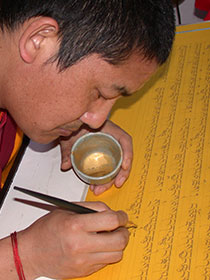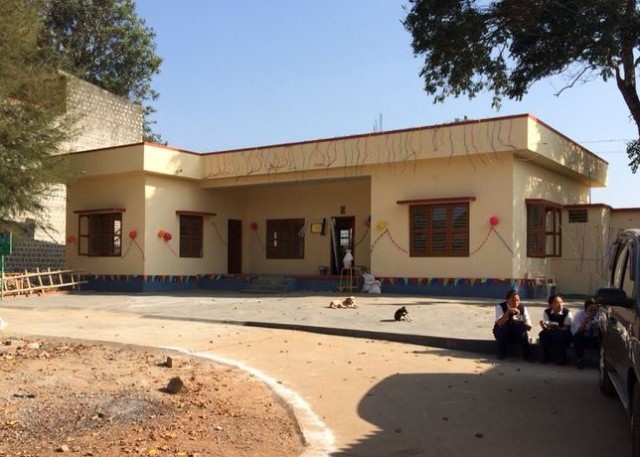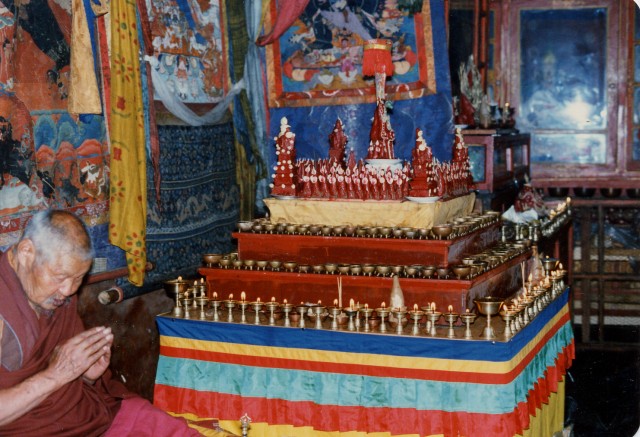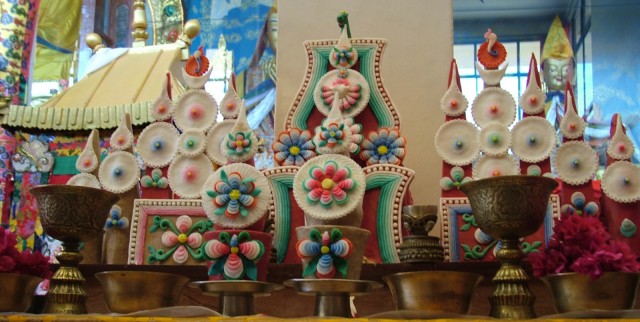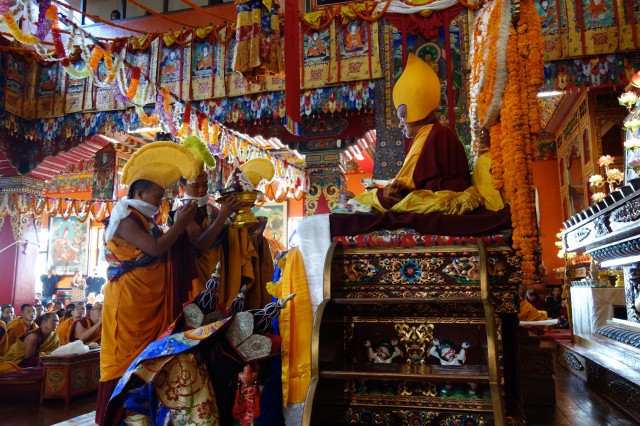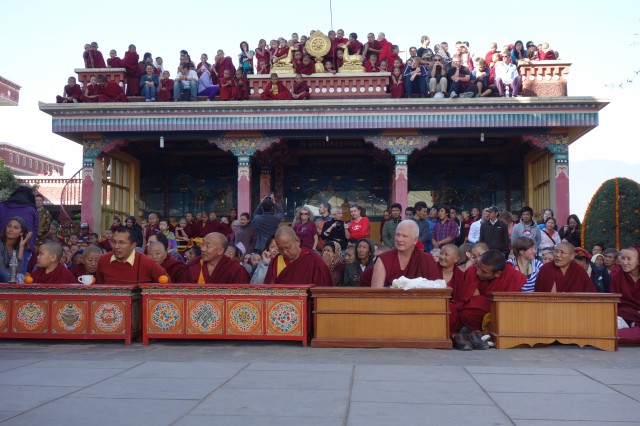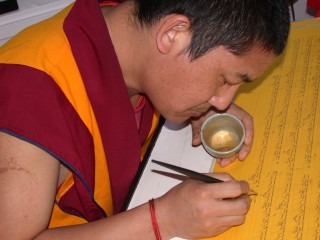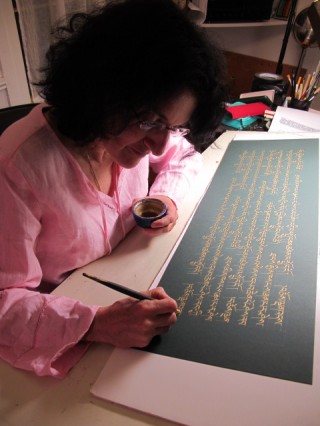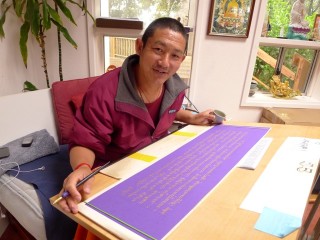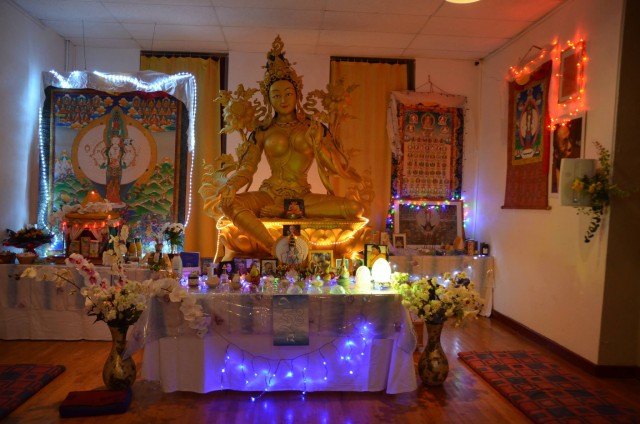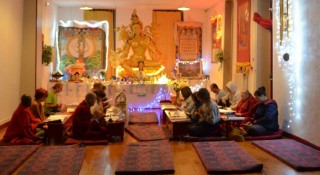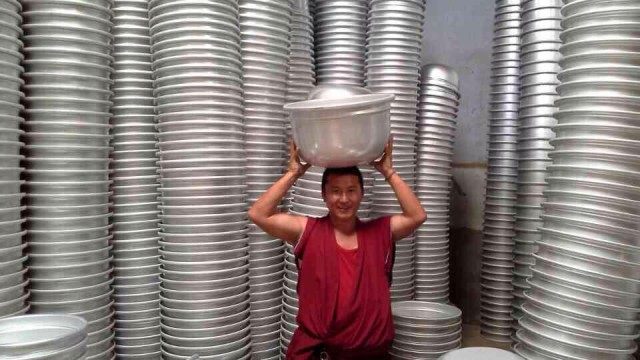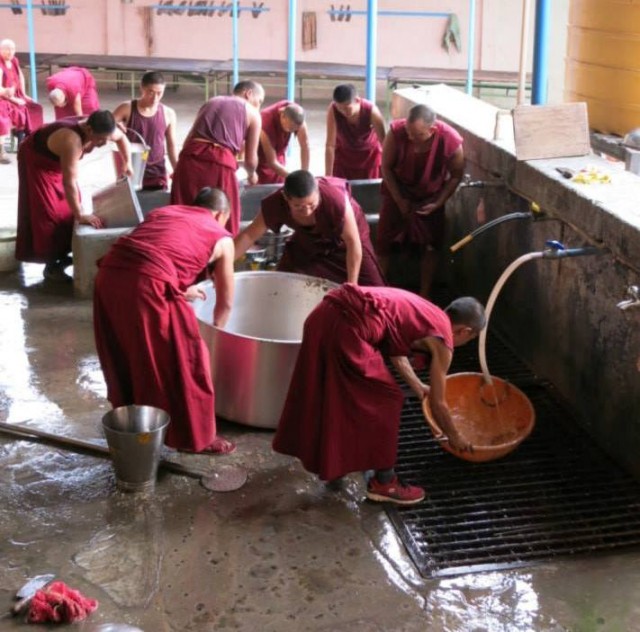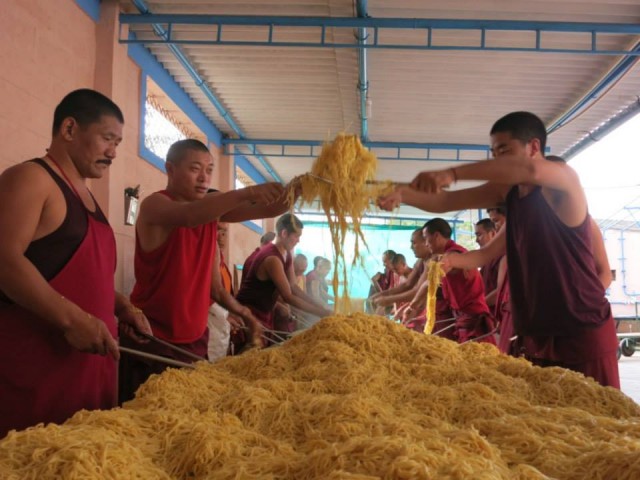- Home
- FPMT Homepage
Foundation for the Preservation of the Mahayana Tradition
The FPMT is an organization devoted to preserving and spreading Mahayana Buddhism worldwide by creating opportunities to listen, reflect, meditate, practice and actualize the unmistaken teachings of the Buddha and based on that experience spreading the Dharma to sentient beings. We provide integrated education through which people’s minds and hearts can be transformed into their highest potential for the benefit of others, inspired by an attitude of universal responsibility and service. We are committed to creating harmonious environments and helping all beings develop their full potential of infinite wisdom and compassion. Our organization is based on the Buddhist tradition of Lama Tsongkhapa of Tibet as taught to us by our founders Lama Thubten Yeshe and Lama Thubten Zopa Rinpoche.
- Willkommen
Die Stiftung zur Erhaltung der Mahayana Tradition (FPMT) ist eine Organisation, die sich weltweit für die Erhaltung und Verbreitung des Mahayana-Buddhismus einsetzt, indem sie Möglichkeiten schafft, den makellosen Lehren des Buddha zuzuhören, über sie zur reflektieren und zu meditieren und auf der Grundlage dieser Erfahrung das Dharma unter den Lebewesen zu verbreiten.
Wir bieten integrierte Schulungswege an, durch denen der Geist und das Herz der Menschen in ihr höchstes Potential verwandelt werden zum Wohl der anderen – inspiriert durch eine Haltung der universellen Verantwortung und dem Wunsch zu dienen. Wir haben uns verpflichtet, harmonische Umgebungen zu schaffen und allen Wesen zu helfen, ihr volles Potenzial unendlicher Weisheit und grenzenlosen Mitgefühls zu verwirklichen.
Unsere Organisation basiert auf der buddhistischen Tradition von Lama Tsongkhapa von Tibet, so wie sie uns von unseren Gründern Lama Thubten Yeshe und Lama Thubten Zopa Rinpoche gelehrt wird.
- Bienvenidos
La Fundación para la preservación de la tradición Mahayana (FPMT) es una organización que se dedica a preservar y difundir el budismo Mahayana en todo el mundo, creando oportunidades para escuchar, reflexionar, meditar, practicar y actualizar las enseñanzas inconfundibles de Buda y en base a esa experiencia difundir el Dharma a los seres.
Proporcionamos una educación integrada a través de la cual las mentes y los corazones de las personas se pueden transformar en su mayor potencial para el beneficio de los demás, inspirados por una actitud de responsabilidad y servicio universales. Estamos comprometidos a crear ambientes armoniosos y ayudar a todos los seres a desarrollar todo su potencial de infinita sabiduría y compasión.
Nuestra organización se basa en la tradición budista de Lama Tsongkhapa del Tíbet como nos lo enseñaron nuestros fundadores Lama Thubten Yeshe y Lama Zopa Rinpoche.
A continuación puede ver una lista de los centros y sus páginas web en su lengua preferida.
- Bienvenue
L’organisation de la FPMT a pour vocation la préservation et la diffusion du bouddhisme du mahayana dans le monde entier. Elle offre l’opportunité d’écouter, de réfléchir, de méditer, de pratiquer et de réaliser les enseignements excellents du Bouddha, pour ensuite transmettre le Dharma à tous les êtres. Nous proposons une formation intégrée grâce à laquelle le cœur et l’esprit de chacun peuvent accomplir leur potentiel le plus élevé pour le bien d’autrui, inspirés par le sens du service et une responsabilité universelle. Nous nous engageons à créer un environnement harmonieux et à aider tous les êtres à épanouir leur potentiel illimité de compassion et de sagesse. Notre organisation s’appuie sur la tradition guéloukpa de Lama Tsongkhapa du Tibet, telle qu’elle a été enseignée par nos fondateurs Lama Thoubtèn Yéshé et Lama Zopa Rinpoché.
Visitez le site de notre Editions Mahayana pour les traductions, conseils et nouvelles du Bureau international en français.
Voici une liste de centres et de leurs sites dans votre langue préférée
- Benvenuto
L’FPMT è un organizzazione il cui scopo è preservare e diffondere il Buddhismo Mahayana nel mondo, creando occasioni di ascolto, riflessione, meditazione e pratica dei perfetti insegnamenti del Buddha, al fine di attualizzare e diffondere il Dharma fra tutti gli esseri senzienti.
Offriamo un’educazione integrata, che può trasformare la mente e i cuori delle persone nel loro massimo potenziale, per il beneficio di tutti gli esseri, ispirati da un’attitudine di responsabilità universale e di servizio.
Il nostro obiettivo è quello di creare contesti armoniosi e aiutare tutti gli esseri a sviluppare in modo completo le proprie potenzialità di infinita saggezza e compassione.
La nostra organizzazione si basa sulla tradizione buddhista di Lama Tsongkhapa del Tibet, così come ci è stata insegnata dai nostri fondatori Lama Thubten Yeshe e Lama Zopa Rinpoche.
Di seguito potete trovare un elenco dei centri e dei loro siti nella lingua da voi prescelta.
- 欢迎 / 歡迎
简体中文
“护持大乘法脉基金会”( 英文简称:FPMT。全名:Foundation for the Preservation of the Mahayana Tradition) 是一个致力于护持和弘扬大乘佛法的国际佛教组织。我们提供听闻,思维,禅修,修行和实证佛陀无误教法的机会,以便让一切众生都能够享受佛法的指引和滋润。
我们全力创造和谐融洽的环境, 为人们提供解行并重的完整佛法教育,以便启发内在的环宇悲心及责任心,并开发内心所蕴藏的巨大潜能 — 无限的智慧与悲心 — 以便利益和服务一切有情。
FPMT的创办人是图腾耶喜喇嘛和喇嘛梭巴仁波切。我们所修习的是由两位上师所教导的,西藏喀巴大师的佛法传承。
繁體中文
護持大乘法脈基金會”( 英文簡稱:FPMT。全名:Found
ation for the Preservation of the Mahayana Tradition ) 是一個致力於護持和弘揚大乘佛法的國際佛教組織。我們提供聽聞, 思維,禪修,修行和實證佛陀無誤教法的機會,以便讓一切眾生都能 夠享受佛法的指引和滋潤。 我們全力創造和諧融洽的環境,
為人們提供解行並重的完整佛法教育,以便啟發內在的環宇悲心及責 任心,並開發內心所蘊藏的巨大潛能 — 無限的智慧與悲心 – – 以便利益和服務一切有情。 FPMT的創辦人是圖騰耶喜喇嘛和喇嘛梭巴仁波切。
我們所修習的是由兩位上師所教導的,西藏喀巴大師的佛法傳承。 察看道场信息:
- FPMT Homepage
- News/Media
-
- Study & Practice
-
-
- About FPMT Education Services
- Latest News
- Programs
- New to Buddhism?
- Buddhist Mind Science: Activating Your Potential
- Heart Advice for Death and Dying
- Discovering Buddhism
- Living in the Path
- Exploring Buddhism
- FPMT Basic Program
- FPMT Masters Program
- FPMT In-Depth Meditation Training
- Maitripa College
- Lotsawa Rinchen Zangpo Translator Program
- Universal Education for Compassion & Wisdom
- Online Learning Center
-
- Prayers & Practice Materials
- Overview of Prayers & Practices
- Full Catalogue of Prayers & Practice Materials
- Explore Popular Topics
- Benefiting Animals
- Chenrezig Resources
- Death & Dying Resources
- Lama Chopa (Guru Puja)
- Lama Zopa Rinpoche: Compendium of Precious Instructions
- Lama Zopa Rinpoche: Life Practice Advice
- Lama Zopa Rinpoche Practice Series
- Lamrim Resources
- Mantras
- Prayer Book Updates
- Purification Practices
- Sutras
- Thought Transformation (Lojong)
- Audio Materials
- Dharma Dates - Tibetan Calendar
- Translation Services
- Publishing Services
- Ways to Offer Support
- Prayers & Practice Materials
-
- Teachings and Advice
- Find Teachings and Advice
- Lama Zopa Rinpoche Advice Page
- Lama Zopa Rinpoche: Compendium of Precious Instructions
- Lama Zopa Rinpoche Video Teachings
- ༧སྐྱབས་རྗེ་བཟོད་པ་རིན་པོ་ཆེ་མཆོག་ནས་སྩལ་བའི་བཀའ་སློབ་བརྙན་འཕྲིན།
- Podcasts
- Lama Yeshe Wisdom Archive
- Buddhism FAQ
- Dharma for Young People
- Resources on Holy Objects
- Teachings and Advice
-
-
*If a menu item has a submenu clicking once will expand the menu clicking twice will open the page.
-
-
- Centers
-
- Teachers
-
- Projects
-
-
-
-
*If a menu item has a submenu clicking once will expand the menu clicking twice will open the page.
-
-
- FPMT
-
-
-
-
-
Our grabbing ego made this body manifest, come out. However, instead of looking at it negatively, we should regard it as precious. We know that our body is complicated, but from the Dharma point of view, instead of putting ourselves down with self-pity, we should appreciate and take advantage of it. We should use it in a good way.
Lama Thubten Yeshe
-
-
-
- Shop
-
-
-
The Foundation Store is FPMT’s online shop and features a vast selection of Buddhist study and practice materials written or recommended by our lineage gurus. These items include homestudy programs, prayers and practices in PDF or eBook format, materials for children, and other resources to support practitioners.
Items displayed in the shop are made available for Dharma practice and educational purposes, and never for the purpose of profiting from their sale. Please read FPMT Foundation Store Policy Regarding Dharma Items for more information.
-
-
Projects
13

Lama Zopa Rinpoche in front of the first statue of Lama Yeshe commissioned by Vajrapani Institute, November, 2013.
Lama Zopa Rinpoche was very happy to make an offering of US$10,000 toward a new life-sized statue of Lama Yeshe which Vajrapani Institute, Boulder Creek, CA, USA is having built. This will be the second life-sized statue of Lama Yeshe commissioned by Vajrapani Institute.
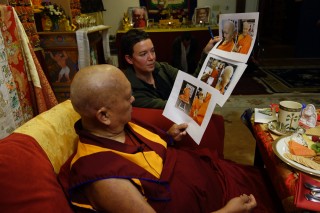
Lama Zopa Rinpoche and director of Vajrapani Institute, Fabienne, discussing the art for the new Lama Yeshe statue.
In February 2011, Vajrapani Institute asked Lama Zopa Rinpoche for advice regarding how to create the causes needed for the retreat center to further flourish and benefit many beings. Rinpoche recommended them to commission another statue of FPMT’s founder, Lama Thubten Yeshe.
Rinpoche also added that Vajrapani’s future new meditation hall should contain one-thousand statues of Lama Yeshe! This statue will act as the prototype for smaller ones to be made available.
The budget for this statue is estimated at US$20,000. Please rejoice that Lama Zopa Rinpoche has offered half of funds needed to complete this beneficial statue.
You may donate any amount to the Lama Zopa Rinpoche Bodhichitta Fund which allows Rinpoche’s compassionate charitable activity to flourish:
13
Sera Monastery is located in the Tibetan settlement Bylakuppe near Mysore, Karnataka in South India. Lama Zopa Rinpoche sponsored the new kitchen at the Bylakuppe School for Tibetans, which was inaugurated on December 19, 2013.
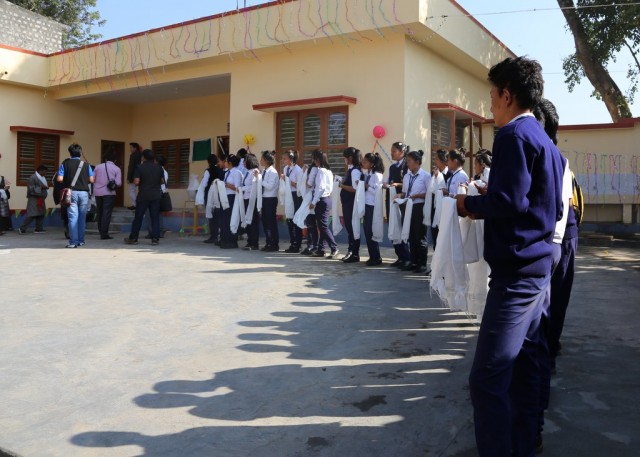
Bylakuppe School for Tibetans students greeting Lama Zopa Rinpoche, India, December 2013. Photo by Ven. Roger Kunsang.
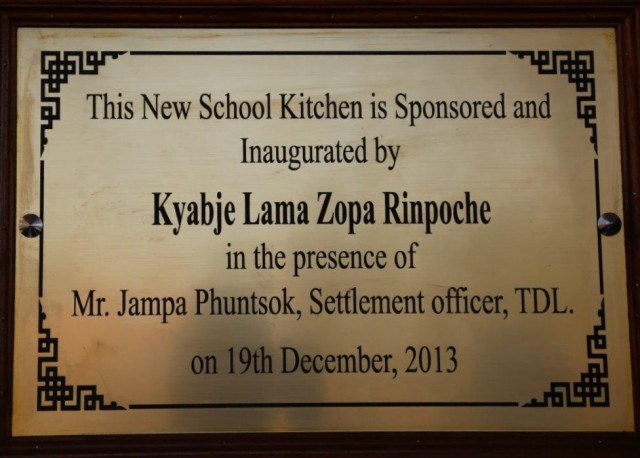
Plaque commemorating the new kitchen, Bylakuppe, Karnataka, India, December 2013. Photo by Ven. Roger Kunsang.
Lama Zopa Rinpoche is the spiritual director of the Foundation for the Preservation of Mahayana Tradition (FPMT), an organization dedicated to preserving Mahayana Buddhism through offering the Buddha’s authentic teachings and to facilitating reflection, meditation, practice and the opportunity to actualize and directly experience the Buddha’s teachings. Sign up to receive news and updates.
- Tagged: bylakuppe, lama zopa rinpoche, mandala
- 0
10
Gold Leafing and Equipment Offered to 70 ft Statue of Padmasambhava

The very famous Padmasambhava statue that is called “Looks Like Me” in Tibet that Lama Zopa Rinpoche often uses as an example.
The Padmasambhava Project for Peace is dedicated to fulfilling Lama Zopa Rinpoche’s goal of building many large statues of Padmasambhava around the world in order to create the cause for peace for all beings
In October of 2013 the project offered US$7,000 for gold and equipment needed for gold leafing a 70 ft Padmasambhava statue with two consorts. A very skilled artist began the tremendous task of gold leafing this large statue. Scaffolding was set up and the artist spent time training some of the local monks in the gold leafing process. This year only one month of work was done due to the onset of Winter, but the gold leafing will continue next few years.
You are welcome to offer any amount toward this amazing offering of gold to Padmasambhava.
Listen, beautiful one having the form of a goddess,
For those sentient beings who have not met me,
Statues of me in the future
Will become the light eliminating the darkness of ignorance.
Whoever builds such statues of me,
Which become objects of offering and so forth,
All their future lives will become meaningful
And they will establish the banner of the teachings.
—Padmasambhava
7
Update on the Stupa to Minimize Harm From the Elements
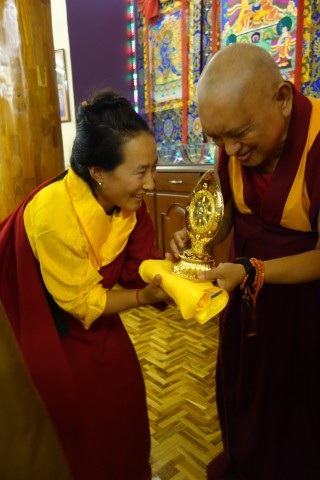
Lama Zopa Rinpoche and Khadro-la at Sera Je Monastery, December 2013. Khadro-la has given extensive advice about a stupa that must be built in California in order to minimize harm from potential earthquakes.
In order to minimize harm caused by possible earthquakes in California, USA; a stupa is being built near the Golden Gate Bridge, under the advice of Rangjung Neljorma Khadro Namsel Drönme (Khadro-la). This project is called the Stupa to Minimize Harm from the Elements.
An incredible amount of groundwork has been done in relation to the building of this important stupa. In June 2013 Drew Bagdasarian of DRB Associates, a professional project management firm, became the project manager of the Stupa to Minimize Harm from the Elements project.
Khadro-la identified a very specific area in San Francisco that the stupa should be built for the most possible benefit. The project is currently in pursuit of appropriate sites in the Presidio and Fort Mason Areas of San Francisco. Mr. Bagdasarian has been diligently working on locating appropriate sites and approaching the companies and owners of properties. As to be expected with a project of this magnitude and importance, some difficulties have presented themselves. For instance, local restrictions as well as lack of available land have provided challenges.
Lama Zopa Rinpoche and Khadro-la are being updated regularly on the progress of this project and giving instructions accordingly so that the appropriate location can be obtained and the stupa built as quickly as possible.
This is an extremely important project. Lama Zopa Rinpoche recently remarked that we typically offer prayers and try to help after disasters happen. But in this case, we can do something to actually stop a disaster from happening. This is an amazing and great opportunity to prevent much suffering and hardship to many.
Lama Zopa Rinpoche has also requested all of the FPMT centers in the Bay Area to begin offering regular prayers in order to prevent earthquakes.
Please keep this hugely important project in your prayers. You are also welcome to donate any amount toward this stupa’s completion.
3

Over 1,000 monks and several hundred international students participated in a long life puja offered to Lama Zopa Rinpoche, December 22, 2013 at Drati Khantsen, Sera Je Monastery, India.
On December 22, 2013 at the conclusion of this year’s oral transmission of Most Secret Hayagriva given by Lama Zopa Rinpoche, Sera Je Monastery’s Drati Khangtsen in India offered a long life puja to Lama Zopa Rinpoche.
Ven. Roger Kunsang, CEO of FPMT and assistant to Lama Zopa Rinpoche, made strong request for Rinpoche’s long life and made an offering on behalf of the whole FPMT organization during the puja. There were over 1,000 monks and several hundred international students in attendance, including 70 FPMT centers represented and about 17 FPMT Geshes.
Please rejoice in this amazing offering, please make prayers for Lama Zopa Rinpoche’s long and healthy life so we may always be guided by his perfect example.
If you would like to donate to this fund, which sponsors long life pujas for Lama Zopa Rinpoche, you may do so at any time.
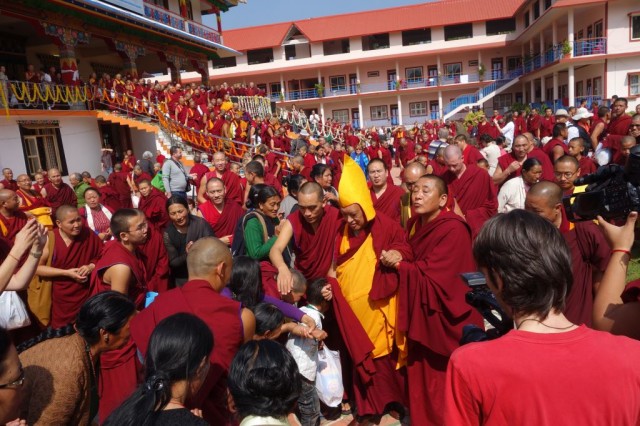
Lama Zopa Rinpoche leaving the long life puja offered on December 22, 2013, at Drati Khantsen, Sera Je Monastery, India.
- Tagged: fpmt projects, long life puja, long life puja fund
31
Monthly Extensive Most Secret Hayagriva Puja Offered
Every month on the Tibetan 29th day, an important day to offer protector pujas, The Puja Fund sponsors about 40 of the most senior monks of Sera Je Monastery, who specialize in the practice of Most Secret Hayagriva, to offer the Extensive Most Secret Hayagriva puja (Hayagriva Tsog Kong). This is an all day puja with an elaborate torma offering (pictured above) and extensive prayers and meditation. 150 rs is offered to each monk offering this puja.
The Extensive Most Secret Hayagriva puja is dedicated to all FPMT centers, services, projects; the success of all Dharma activities and removal of obstacles; to all students who are facing obstacles; to the benefactors of the Puja Fund and to all beings.
The Puja Fund makes a small offering to the 40 monks who perform the puja; offers breakfast, lunch and dinner; and covers the cost of extensive torma offerings for the puja.
Every Tibetan 29th day (This month it is: December 31, 2013), you can remember that there are over 40 monks performing the Extensive Most Secret Hayagriva puja. This is something amazing to rejoice in, to mentally offer and dedicate towards and also something you can participate in by donating any amount … How amazing!
You may donate toward this monthly puja and the entire array of ongoing offerings sponsored by The Puja Fund:
- Tagged: fpmt projects, fpmt puja fund
28
Annual Long Life Puja for His Holiness the Dalai Lama

Exquisite long life thangka made with pearls which Lama Zopa Rinpoche is offering to His Holiness the Dalai Lama at the upcoming long life puja for His Holiness on behalf of the entire FPMT organization. Photo by Ven. Roger Kunsang.
FPMT has the incredible opportunity to be one of the main sponsors of the long life puja that will be offered to His Holiness the Dalai Lama at the conclusion of this year’s Jangchub Lam-Rim teaching event at Sera Je Monastery. This is His Holiness the Dalai Lama’s continued teachings and transmissions on eighteen classic Lam-rim commentaries.
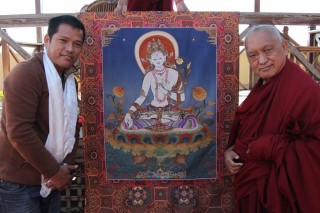
Lama Zopa Rinpoche with the artist who created the incredible long life thangka to be offered to His Holiness the Dalai Lama at the upcoming annual long life puja. Rinpoche worked closely with the artist on all aspects of this thangka’s creation.
FPMT will be organizing the traditional offerings as well as a special thangka of White Tara, that is made completely of tiny pearls, which Lama Zopa Rinpoche has carefully arranged in Nepal, working closely with the artist on the design, brocade, and many details.
An important priority for FPMT is offering long life pujas every year for our immeasurably precious teachers: His Holiness the Dalai Lama and our Spiritual Director, Lama Zopa Rinpoche. Lama Zopa Rinpoche requested the FPMT organization to offer a long life puja to His Holiness the Dalai Lama every year. FPMT International Office has taken on this responsibility, through the Long Life Puja Fund, for twenty years, and will continue to do so, on behalf of the entire organization.
If you would like to contribute to the annual long life puja offered to His Holiness the Dalai Lama on behalf of the entire FPMT organization, you are welcome to offer any amount toward the expenses.
To understand why a long life puja is essential, we must understand the value of the Guru. He is our guide in this life, the bardo, and future lives. He is immensely important. It is not a case where if we ask him to live he will, and vice-versa, but that to offer such a ceremony purifies our own broken samayas.
—Geshe Lama Konchog
24
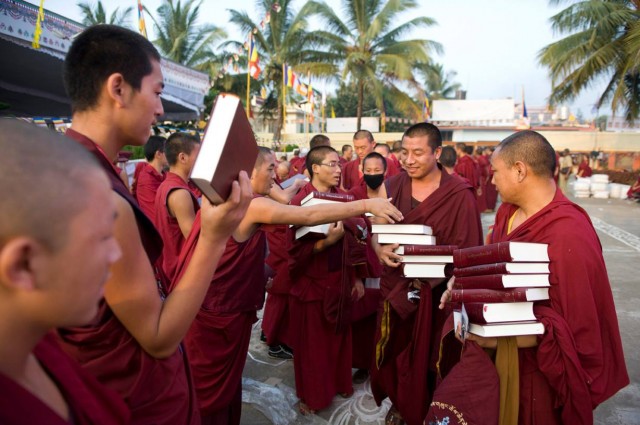
Texts distributed for the 2012 teachings on the 18 Great Lam-Rim Commentaries. The Preserving the Lineage Fund sponsored 50,000 copies of five different texts needed for the teaching event. Photos courtesy of the Jangchup Lam-rim Teachings website.
In November 2012, on the very auspicious occasion of the 610th Anniversary of Lama Tsongkhapa’s composition of his masterpiece Lam-rim Chen-mo (The Great Treatise on the Stages of the Path to Enlightenment) and the 600th Anniversary of Lama Tsongkhapa’s teaching of this text at Gaden Monastery for the first time, His Holiness the Dalai Lama began offering teachings and transmissions on eighteen classic Lam-rim commentaries at the request of His Eminence Ling Rinpoche. His Holiness is continuing the incredibly rare teachings and transmissions this year. The teaching event will take place December 25, 2013 – January 3, 2014 at Sera Je Monastery. More details can be found on the event’s website.

The Preserving the Lineage Fund sponsored 50,000 copies of five different texts needed for the teaching event. Photos courtesy of the Jangchup Lam-rim Teachings website.
In 2012 the Preserving the Lineage Fund sponsored the printing of the 50,000 copies of five different texts needed for the teaching event, as well as the bags for all the texts and a sound system for the event. The texts will be utilized again this year.
These incredible teachings are being streamed via live webcast.
You may also download the texts used in the event.
Please rejoice in this incredibly precious and historic event. Sincere thanks to all who have contributed.
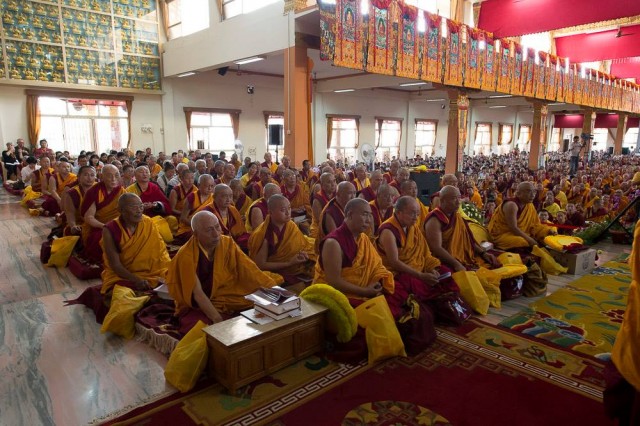
50,000 participants attended this event in 2012 including many high lamas. Lama Zopa Rinpoche can be seen with Choden Rinpoche in the fourth row of this photo.
22
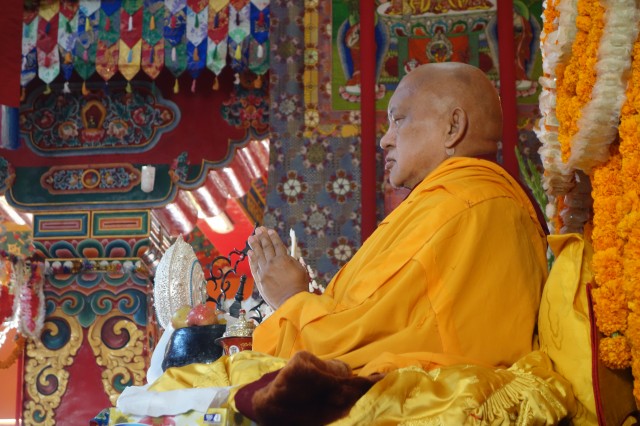
Lama Rinpoche during the long life puja, December 9, 2013, Kopan Monastery, Nepal. Photo Ven. Roger Kunsang.
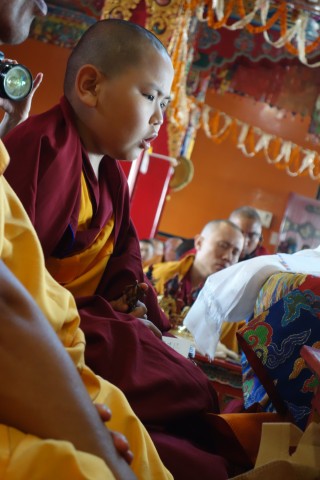
Tenzin Phuntsok Rinpoche, the reincarnation of Geshe Lama Konchog, during the long life puja for Lama Zopa Rinpoche. Photo by Ven. Roger Kunsang.
The annual long life puja was offered to Lama Zopa Rinpoche on behalf of the entire FPMT organization at Kopan Monastery, December 9, 2013. 800+ monks and nuns; 280+ Western students; and many local Nepalis, Tibetans and Sherpas were in attendance.
Tremendous thanks to all who donated to this auspicious and successful ceremony, and to all who generously offered practices for Lama Zopa Rinpoche’s long life.
You are welcome to offer any amount to the Long Life Puja Fund for Lama Zopa Rinpoche at any point during the year. By maintaining harmony, following Rinpoche’s advice and offering long life pujas, FPMT students are accumulating the merit needed for our precious spiritual director to stay in the world with us for a long time.
- Tagged: fpmt projects, long life puja, long life puja fund
14
Ven. Tsering, a Kopan Monk, has dedicated his life to writing out the Prajnaparamita Sutra in pure gold at the request of Lama Zopa Rinpoche. Effort of this magnitude is worth rejoicing in, as this is the eleventh consecutive year he has worked on this project.
Carina Rumrill, on behalf of FPMT Charitable Projects, had the opportunity to ask Ven. Tsering a few questions about this work.
Can you tell me how you began this project? What were you doing before you began this?
[Lama Zopa] Rinpoche told me to work on this project, to write it out in gold. I was doing a translation job in Malaysia, but then, on my second trip to Malaysia, I was about to start a new contract but after a few weeks there was a new letter from Rinpoche saying he wanted me to be here [in California]. The director said, “It is the guru’s wishes,” so we should follow and I went straight to California not knowing what the project would be. I knew that Rinpoche asked me to come, but I didn’t know where, or what. I thought maybe Land of Medicine Buddha. But it was Rinpoche’s house in Aptos [Kachoe Dechne Ling in California, USA]. At first it wasn’t so clear what I would be doing, but after three months Rinpoche told me about this project. That was in 2002. So this is my 11th year.Had you done anything like this before?
No, but maybe [I had] some kind of natural talent in the arts from what I did at Kopan. I had worked with my teacher on Yamantaka three dimensional mandala, some sand mandalas, some art at Kopan. I hadn’t done any calligraphy before. Rinpoche showed me how to do the calligraphy and checked my writing. It wasn’t right at first and had to be corrected. This was a great opportunity to correct my writing and because of Rinpoche’s kindness I could do that.
The day starts at six or seven in the morning. Before I start, I make the glue for the gold I am using. I have to mix water, make sure there is enough to stick the gold to the paper. The gold, which is for statues, is from Nepal. I get the gold ready in the morning then I set up my motivation and I do my morning prayers. It takes about half an hour to set up. Then I start and continue until about 11 or 12 noon. Sometimes I make mistakes and have to correct them, but if everything is mostly okay, I stop and take lunch for about an hour or an hour-and-a-half. Then, around 1:30, I start writing about until 4 p.m. Then I do dedications every day, the dedication is very important.
Do your hands cramp? Has sitting like this every day and writing affected your health at all?
Every day I do exercise afterward. I do exercise to keep my movement, so I think that is important. In order to continue for a long time I must be physically healthy. And so far, my health is good, hand is good.
How many hours a day is this work?
Basically regular, eight hours or so. If I did 10 hours or 13 hours, every day, this wouldn’t be good for the long run. This project is not a small project, it is a very big project. If I do like I am, I can stay stable to continue for a long time. I am not rushing and in that way I can take it easy and carry on.
Can you tell me about the supplies required? What do you use for this?
Gold, paper that Rinpoche chooses, calligraphy pen. The paper is supposed to last for a thousand years. It is also multicolored paper.
There is another FPMT student, Jane, who is also working on the 2nd volume. I’m on the 4th volume, completed the 3rd. So we are working on the same project but on different volumes.
If I had to do it by myself, this would not be possible in this one life. I believe I will be 80 or so when this is finished. One volume took me five years and when Rinpoche is here [in California], I end up doing other projects for Rinpoche, so maybe not as much work on this at times.
When finished it will go into the heart mandala of the Maitreya statue.
Have you personally seen any change in your own mind after working on this most profound teaching on emptiness for eleven years?
Well now I have a strong wish to do this — perseverance — and this comes from understanding why I am doing it and the reasons. Once you know this you develop sincere interest, then the handwriting comes out because of the wish to make this effort. So you take it as your practice … something like that. So in this way, I don’t have to do retreat, but just having one project you receive from your guru, you take it as your project and carry on. Then if you have an attitude like that, I think that is one reason to be able to carry on.
Do you feel having this one focused project has helped your concentration? I know from working in the centers, there is always so much to do, phones ringing or emails coming through, many ways to be distracted by all that needs to be done. Do you feel having this one project helps to concentrate on what needs to be done?
That’s why in the morning, the motivation is so important. Going into the different centers, motivation is to help others, to benefit others, so no matter what conditions come it is always to help others, to benefit other sentient beings, especially the guru. So if you go with that motivation, then there might be some conditions arise, but sometimes it helps to remind of the motivation, one or two times during the day, in order to calm down. If you carry on like that, watch the mind, it does help, and then conditions arise, maybe anger arises, then, maybe recollect again with the motivation.
Before the stroke, Rinpoche was doing some of this. He did talk a lot about this project and the benefits of writing it out in gold. He was working on the short version, 8,000 verses. I am not sure how far he is on this.
Has Rinpoche ever expressed to you about the benefits of what you are doing or said anything about the work you would like to share with others?
Rinpoche says this project is mainly for accumulation of merit so we can build the large Maitreya statue [in Kushinagar, India]. This is also for world peace and for preserving the Buddhadharma, to preserve the teachings of Buddha. For this we need to make effort to create as much merit as possible.
When you are doing the work, does it feel like practice or work?
I don’t know if it is work or not, but because of this project, I found Dharma and I am surviving. It is so beneficial for me. My heart is getting stronger than ever before.
I feel I have had a lot of purification and accumulation of merit working on this project. These teachings on emptiness, benefit me a lot, they open my eyes and also my heart.
Very happy. Very, very blessed to be doing the work. So blessed, the most lucky one, the most fortunate one in the whole world to do this. After about 10 years I realized how lucky I am, how fortunate that I got this project. At the beginning maybe I was not so clear what the reason was so questions were coming. Now I slowly start to understand and the more I understand the more fortunate I feel and then the more willingness comes.
When people come and visit they admire this work once they see it. No one visits who doesn’t admire and rejoice. And that is also the practical benefit, a very apparent benefit the people are happy and rejoice about this project. And also that they are happy with me, that my gurus are happy with me, that is an important part to me.
Is there anything you want to express or say about this work? To convey to others, that may be helpful to understand this project?
The gold is getting more expensive; I know it is so hard to get. Maybe others can help to contribute to this so Rinpoche can carry on and I can carry on the wishes of Rinpoche and Lama Yeshe and His Holiness the Dalai Lama. And then also to remove all obstacles to building the big statue of Maitreya.
You can learn more about this project, the benefits, and history by visiting the Prajnaparamita Project‘s webpage.
- Tagged: prajnaparamita project
11
On November 15, students began the first of 108 Nyung-Nä retreats at Institut Vajra Yogini, France. Four of these students are sponsored by the Lama Zopa Rinpoche Bodhichitta Fund. The retreats will be completed in June of 2014. The cost to offer this sponsorship is US$9,876.
In 2012 the fund also sponsored four people to complete 108 Nyung-Nä retreats. These sponsorships are the continued expression of one of Lama Zopa Rinpoche’s Vast Visions for FPMT which he explained in 2007.
The Nyung Nä retreat is a two-day intensive practice that includes taking the 24-hour Mahayana precepts with the addition of complete fasting and silence on the second day.
Doing even one Nyung Nä or “abiding in retreat” for just two days is said to be as effective as three months of other purification practices and is extremely powerful for healing illness, purifying negative karma, and opening the heart to compassion.
Please rejoice in these practitioners’ effort, this is a difficult retreat to complete and they have committed to 108 completions!
This practice is a trillion, billion times greater than becoming an Olympic champion. Doing so many Nyung-Näs you become an unbelievable champion, this is what makes numberless Buddhas and Bodhisattvas most happy and brings sentient beings to enlightenment as quickly as possible. This is an extremely powerful practice, it in an incredible way to develop bodhichitta.
—Lama Zopa Rinpoche
You are welcome to donate any amount to the Lama Zopa Rinpoche Bodhichitta Fund and contribute to beneficial sponsorships like these.
8
Update from the Sera Je Food Fund
The Sera Je Food Fund continues to offer three nutritious meals daily for all 2,500 monks living at Sera Je Monastery in southern India. We currently offer 3,029,500 meals every year, that is 8,300 every day!
This project is only possible due to a massive and collective effort of many volunteers at the monastery (who shop for, prepare, and clean up after each meal) as well as many kind donors who contribute to this fund.
Here are a few recent photos which illustrate the many aspects of this incredibly beneficial project.
If you would like to contribute to the Sera Je Food Fund, you may offer any amount you are able.
- US$10: Provides three vegetarian meals a day to one monk for one month
- US$120: Provides three vegetarian meals a day to one monk for one year
- US$780: Provides three vegetarian meals a day to all 2,500 monks for one day
- US$5,460: Provides three vegetarian meals a day to all 2,500 monks for one week
- US$280,000: Provides three vegetarian meals a day to all the 2,500 monks for one year
- Home
- News/Media
- Study & Practice
- About FPMT Education Services
- Latest News
- Programs
- New to Buddhism?
- Buddhist Mind Science: Activating Your Potential
- Heart Advice for Death and Dying
- Discovering Buddhism
- Living in the Path
- Exploring Buddhism
- FPMT Basic Program
- FPMT Masters Program
- FPMT In-Depth Meditation Training
- Maitripa College
- Lotsawa Rinchen Zangpo Translator Program
- Universal Education for Compassion & Wisdom
- Online Learning Center
- Prayers & Practice Materials
- Overview of Prayers & Practices
- Full Catalogue of Prayers & Practice Materials
- Explore Popular Topics
- Benefiting Animals
- Chenrezig Resources
- Death & Dying Resources
- Lama Chopa (Guru Puja)
- Lama Zopa Rinpoche: Compendium of Precious Instructions
- Lama Zopa Rinpoche: Life Practice Advice
- Lama Zopa Rinpoche Practice Series
- Lamrim Resources
- Mantras
- Prayer Book Updates
- Purification Practices
- Sutras
- Thought Transformation (Lojong)
- Audio Materials
- Dharma Dates – Tibetan Calendar
- Translation Services
- Publishing Services
- Teachings and Advice
- Find Teachings and Advice
- Lama Zopa Rinpoche Advice Page
- Lama Zopa Rinpoche: Compendium of Precious Instructions
- Lama Zopa Rinpoche Video Teachings
- ༧སྐྱབས་རྗེ་བཟོད་པ་རིན་པོ་ཆེ་མཆོག་ནས་སྩལ་བའི་བཀའ་སློབ་བརྙན་འཕྲིན།
- Podcasts
- Lama Yeshe Wisdom Archive
- Buddhism FAQ
- Dharma for Young People
- Resources on Holy Objects
- Ways to Offer Support
- Centers
- Affiliates Area
- Teachers
- Projects
- Charitable Projects
- Make a Donation
- Applying for Grants
- News about Projects
- Other Projects within FPMT
- Support International Office
- Projects Photo Galleries
- Give Where Most Needed
- FPMT
- Shop
Translate*
*powered by Google TranslateTranslation of pages on fpmt.org is performed by Google Translate, a third party service which FPMT has no control over. The service provides automated computer translations that are only an approximation of the websites' original content. The translations should not be considered exact and only used as a rough guide.Anybody who dedicates their life to achieving lam rim realizations with the goal to liberate numberless beings from the oceans of samsaric suffering and to bring to enlightenment, this is what I regard as the most important thing in the world.







